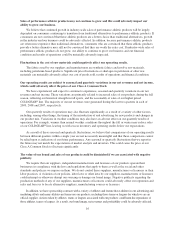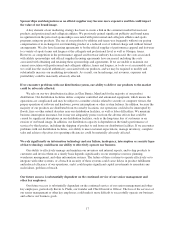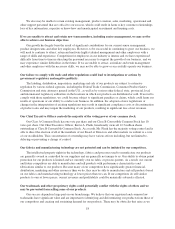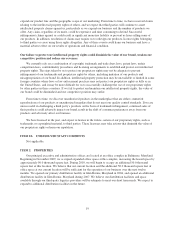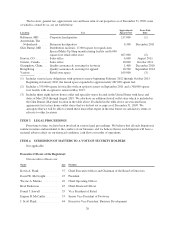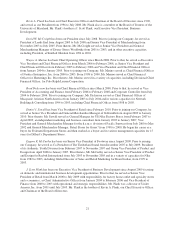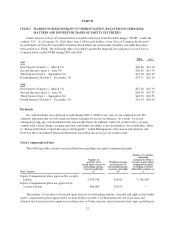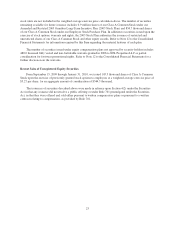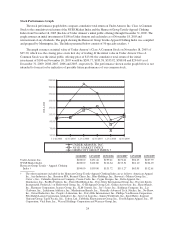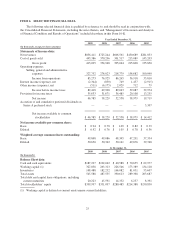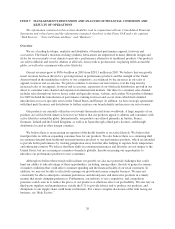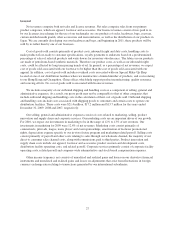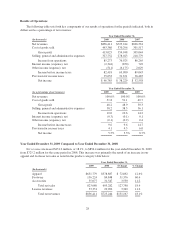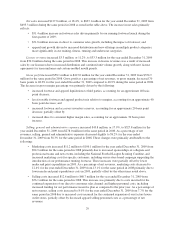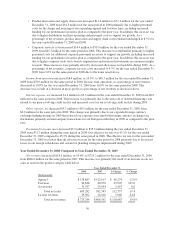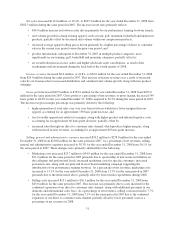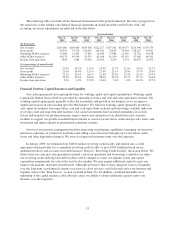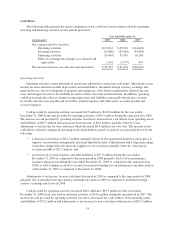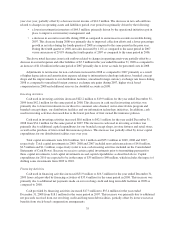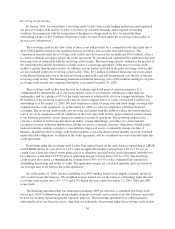Under Armour 2009 Annual Report Download - page 34
Download and view the complete annual report
Please find page 34 of the 2009 Under Armour annual report below. You can navigate through the pages in the report by either clicking on the pages listed below, or by using the keyword search tool below to find specific information within the annual report.ITEM 7. MANAGEMENT’S DISCUSSION AND ANALYSIS OF FINANCIAL CONDITION AND
RESULTS OF OPERATIONS
The information contained in this section should be read in conjunction with our Consolidated Financial
Statements and related notes and the information contained elsewhere in this Form 10-K under the captions
“Risk Factors,” “Selected Financial Data,” and “Business.”
Overview
We are a leading developer, marketer and distributor of branded performance apparel, footwear and
accessories. The brand’s moisture-wicking synthetic fabrications are engineered in many different designs and
styles for wear in nearly every climate to provide a performance alternative to traditional products. Our products
are sold worldwide and worn by athletes at all levels, from youth to professional, on playing fields around the
globe, as well as by consumers with active lifestyles.
Our net revenues grew to $856.4 million in 2009 from $281.1 million in 2005. We believe that our growth
in net revenues has been driven by a growing interest in performance products and the strength of the Under
Armour brand in the marketplace relative to our competitors, as evidenced by the increases in our sales of
apparel, footwear and accessories. We plan to continue to increase our net revenues over the long term by
increased sales of our apparel, footwear and accessories, expansion of our wholesale distribution, growth in our
direct to consumer sales channel and expansion in international markets. Our direct to consumer sales channel
includes sales through our factory house outlet and specialty stores, website, and catalog. New product offerings
for 2009 included the introduction of performance running footwear and soccer cleats which had a limited
introduction at soccer specialty stores in the United States and Europe. In addition, we have strategic agreements
with third party licensees and distributors to further reinforce our brand identity and increase our net revenues.
Our products are currently offered in over twenty thousand retail stores worldwide. A large majority of our
products are sold in North America; however we believe that our products appeal to athletes and consumers with
active lifestyles around the globe. Internationally, our products are offered primarily in Austria, France,
Germany, Ireland and the United Kingdom, as well as in Japan through a third-party licensee, and through
distributors located in other foreign countries.
We believe there is an increasing recognition of the health benefits of an active lifestyle. We believe this
trend provides us with an expanding consumer base for our products. We also believe there is a continuing shift
in consumer demand from traditional non-performance products to our performance products, which are intended
to provide better performance by wicking perspiration away from the skin, helping to regulate body temperature
and enhancing comfort. We believe that these shifts in consumer preferences and lifestyles are not unique to the
United States, but are occurring in a number of markets globally, thereby increasing our opportunities to
introduce our performance products to new consumers.
Although we believe these trends will facilitate our growth, we also face potential challenges that could
limit our ability to take advantage of these opportunities, including, among others, the risk of general economic
or market conditions that could affect consumer spending and the financial health of our retail customers. In
addition, we may not be able to effectively manage our growth and a more complex business. We may not
consistently be able to anticipate consumer preferences and develop new and innovative products in a timely
manner that meets changing preferences. Furthermore, our industry is very competitive, and competition
pressures could cause us to reduce the prices of our products or otherwise affect our profitability. We also rely on
third-party suppliers and manufacturers outside the U.S. to provide fabrics and to produce our products, and
disruptions to our supply chain could harm our business. For a more complete discussion of the risks facing our
business, see “Risk Factors.”
26


